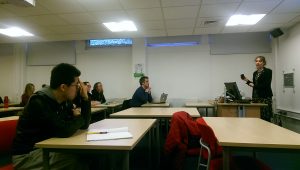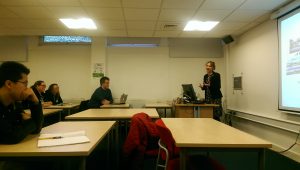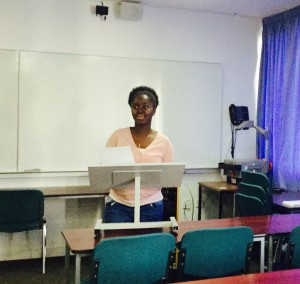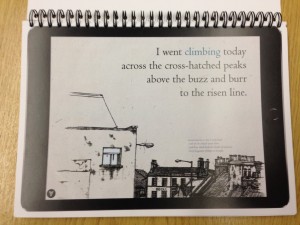 At 2.45pm on 6th October, with a retinue of publishing students bearing boxes of precious periodicals, Nikki Simpson (Business Manager at the PPA – Professional Publishers Association) strode through the seemingly endless corridors of the University of Stirling. She was a woman with a mission. Her aim, to convert Unbelievers – those students convinced that their future lies 100% in the world of book publishing rather than that of the magazine.
At 2.45pm on 6th October, with a retinue of publishing students bearing boxes of precious periodicals, Nikki Simpson (Business Manager at the PPA – Professional Publishers Association) strode through the seemingly endless corridors of the University of Stirling. She was a woman with a mission. Her aim, to convert Unbelievers – those students convinced that their future lies 100% in the world of book publishing rather than that of the magazine.
A passionate presenter, Nikki soon had many of the most hardened book career diehards rethinking their options and goals. The PPA represents over 700 magazines in Scotland, an industry valued at £154m which supports 1,300 full-time, 560 part-time and 4,400 freelancers. DC Thomson is the largest employer with around 600 employees, but the smallest publisher could have a couple of people working on a “passion project”. Annual events, the international Magfest (make a note in your diary, 15th Sep 17) and the Scottish Magazine Awards (The Beano won in 2015), provide the perfect platforms for the industry to celebrate the drive and passion of those working to produce regular magazines of the highest quality. The PPA is also planning to open a centre for magazine publishing in Edinburgh which would act as a hub for the industry and raise the profile of the sector. Exciting times!
 There are three areas of periodical publishing – Consumer, B2B and Contract. The boxes were soon opened and magazines representing each of these areas passed around. To appreciate magazines, it’s vital to get hands on and we certainly did. Delighted sounds filled the room as we were given a design lesson in the art of the mag. Everyone is familiar with the glossy mag, but what caught the imagination in Nikki’s presentation was the sheer variety of paper stock used and glorious typography and images. Smooth, matt, cut outs, glow in the dark, QR codes, VR – seemingly unlimited creative options. Titles like Modern Farmer, Delayed Gratification, Boat, Little White Lies, Oh Comely, ‘Sup, the Gentlewoman and Hot Rum Cow had many fans and turned the head of many a committed book careerist on the day.
There are three areas of periodical publishing – Consumer, B2B and Contract. The boxes were soon opened and magazines representing each of these areas passed around. To appreciate magazines, it’s vital to get hands on and we certainly did. Delighted sounds filled the room as we were given a design lesson in the art of the mag. Everyone is familiar with the glossy mag, but what caught the imagination in Nikki’s presentation was the sheer variety of paper stock used and glorious typography and images. Smooth, matt, cut outs, glow in the dark, QR codes, VR – seemingly unlimited creative options. Titles like Modern Farmer, Delayed Gratification, Boat, Little White Lies, Oh Comely, ‘Sup, the Gentlewoman and Hot Rum Cow had many fans and turned the head of many a committed book careerist on the day.
It’s worth remembering that the big players are those with circulations audited every six months by ABC (Audit Bureau of Circulations). The UK top five are: supermarket mags for Asda, then Tesco; TV Choice, What’s On TV, and Waitrose magazine. Their combined circulation figures, a mighty 6.8 million.
What makes a magazine successful? Nikki explained that in addition to the basic funding models of subscriptions, copy sales, advertising, and crowdfunding, brand extensions via websites, apps, award nights, supplements (even shops in the case of Tyler Brule’s Monocle) are all so important. The issue of ad blocking was discussed. Half of us in the room admitted to using these. After Nikki’s cri de coeur against their use for magazine sites, “Die! Die!” but “I love your content!” and the particularly vivid “ad blockers stab newspapers in the face”, those students using adblockers were swearing off using them again.
Nikki covered 16 possible career areas in magazine publishing from design to insight, through ad sales and procurement – and editorial, of course – as it’s always worth keeping an open mind regarding opportunity for experience.
She rounded off her rallying call for magazines with examples of cutting edge creativity – links below.
Marie Claire
Augmented Reality
Following questions from the audience, those magazines which had been objects of desire during the talk were handed over to some lucky recipients, and our first visitor talk in this semester came to an end. Nikki’s presentation had qualities essential for a career in magazine publishing – passion and creativity – and she succeeded in making many of us consider a career in magazines for the first time.
By Morven Gow
 When, on Sunday 2nd October, news started trickling in about the Italian author Elena Ferrante’s
When, on Sunday 2nd October, news started trickling in about the Italian author Elena Ferrante’s  The new academic year has started up again, and we’re delighted to welcome the
The new academic year has started up again, and we’re delighted to welcome the 



















